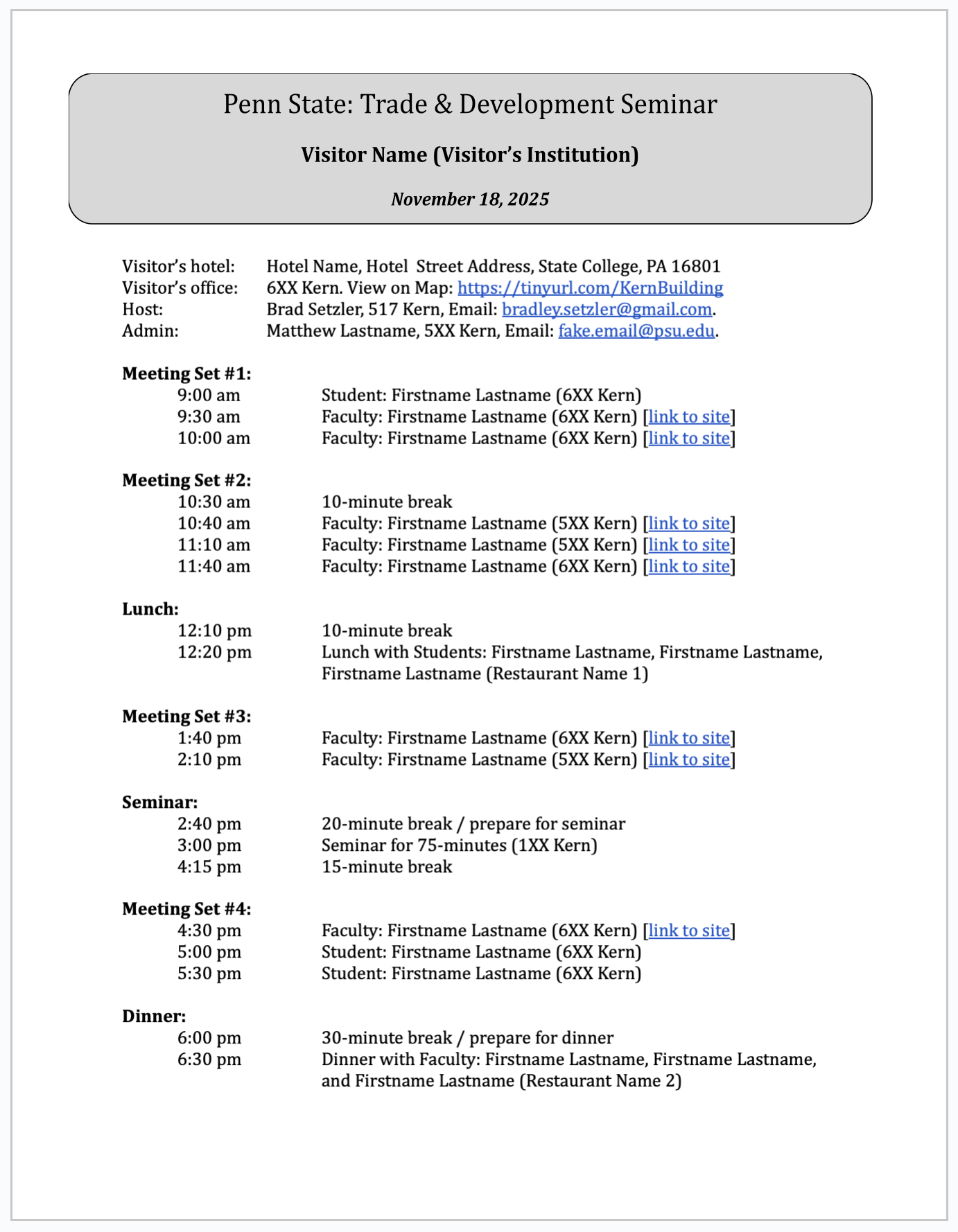Organizing a Seminar
During a typical seminar visit, an external visitor travels to a university, spends the day meeting with local faculty and students, is taken to lunch and dinner, and presents research. The local organizer is responsible for inviting the speaker, organizing the speaker’s schedule, preparing the seminar environment, and ensuring the speaker has all relevant information.
The following are tips for a hypothetical faculty member who is organizing a seminar day for an external visitor, based on my own trial-and-error from organizing a seminar for the first time as an assistant professor at Penn State.
Tip #1. Provide key information when inviting the speaker.
When inviting a speaker to visit your institution, include the following information:
- Your first and last name;
- The name of your institution;
- The field or topic of the seminar;
- The available dates from which to choose;
- The outline of how the day will be spent;
- Who will book and pay for the travel-related expenses; and,
- Any special considerations, e.g., that early-stage research is preferred.
Here is a complete invitation email:
Dear Michael,
Hope all is well! I am organizing the Trade & Development Seminar at Penn State this year and would like to invite you to visit.
The seminar is 75-minutes on Monday afternoons, with one-on-one meetings scheduled throughout the day. A student lunch and faculty dinner are also arranged. We will book the hotel and reimburse travel expenses.
The following dates are currently available for your visit: Sept 18, Sept 25, and Oct 23.
Please let me know which date works best for you. Hope you can make it!
Brad Setzler
Tip #2. Confirm the visit and provide an administrative contact.
After the speaker replies with a chosen date, reply to let them know that the visit date is confirmed.
When confirming, provide them with the name and email address of an administrator whom they may contact to answer financial and logistical questions.
Here is an example of a confirmation email:
Dear Michael,
Thanks for your reply – we have your visit confirmed for Sept 25.
I have also cc’ed the seminar administrator, Matthew Lastname, who can help you with any issues related to the hotel booking, reimbursement, and the like.
We look forward to your visit!
Brad
Tip #3. Provide complete information regarding whom the visitor will meet.
It is common to provide visitors with a meeting schedule that says something like:
11:00 AM - Meet with Brad
There are 4 pieces of useful information missing from this entry:
- Provide the last name: The speaker should not have to search the faculty directory to uncover the last names of the individuals with whom they are meeting – provide the last names by default.
- Provide the meeting location: Unless all meetings will be in a single room, make sure to provide the room number of each meeting, as well as the building if multiple buildings are involved.
- Indicate the position: Make sure to indicate if the individual is a faculty member, a visitor, a student, the provost, or another position.
- Provide the website: Visitors will likely want to familiarize themselves with the research of the local faculty members prior to the meeting. Make this easy by providing faculty website links.
Here is a complete meeting entry:
11:00 AM | Faculty Meeting: Brad Setzler (Kern 517) [ website]
See the template below for an example of how to fit this information onto a day schedule.
Tip #4. Schedule short breaks for your visitors throughout the day.
Many seminar schedules look like this:
9:00 AM | 30-minute Meeting 1
9:30 AM | 30-minute Meeting 2
10:00 AM | 30-minute Meeting 3
10:30 AM | 30-minute Meeting 4
11:00 AM | 30-minute Meeting 5
11:30 AM | 30-minute Meeting 6
While keeping all of the meeting times on the half-hour may seem convenient, it creates a predicament for the visitor – when can they take a break? Human beings need breaks throughout the day for several good reasons:
Family considerations: Visitors are leaving their dependents behind to spend the day at your institution. However, they often need to check in with family throughout the day to ensure that the necessary care is being provided.
Restroom visits: The average human being needs to use the restroom 7 times per waking day, with many requiring 10 visits, according to the Cleveland Clinic. This means it is typical for a healthy human to require a restroom break once every 2 hours.
Medication: Many people suffer from health conditions that require intraday maintenance. For example, diabetes is quite common in the US and often requires active management, such as injecting insulin prior to meals or eating small meals throughout the day.
Given that your visitors likely require short breaks to address these and other issues, schedule those breaks on their behalf. Here is an example:
8:50 AM | 30-minute Meeting 1
9:20 AM | 30-minute Meeting 2
9:50 AM | 30-minute Meeting 3
10:20 AM | 10-minute Break
10:30 AM | 30-minute Meeting 4
11:00 AM | 30-minute Meeting 5
11:30 AM | 30-minute Meeting 6
See the template below for a more complete example of how to fit breaks into the day.
Meeting Template
Here is my meeting template:

As you can see, it is easy to include 11 different 30-minute meetings, a 75-minute seminar, and an 80-minute lunch, despite having several small breaks built in to the schedule.
You can access my template here as a public Google Doc:
Link to Visitor Meeting Schedule Template
Feel free to duplicate it, edit it, share it with your colleagues so that they can choose their meeting times, and export it to PDF when it is ready to share the final version with the seminar visitor.